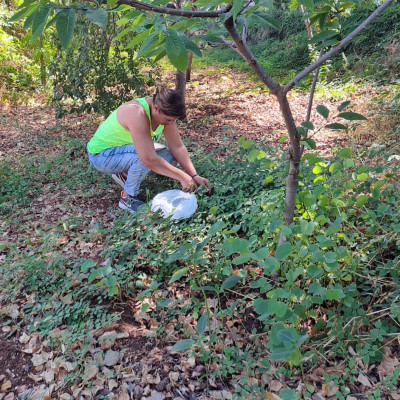Sliq
 In Lebanon, edible wild plants are regarded as valuable food within rural areas. Known as sliq or sliqa in Arabic, deriving from a word belonging to a plant called “saliqa” that grows in the wild, and depends on the amount of rain that falls in the winter. Knowledge about these plants is often passed down through generations by word of mouth, with women being the main beholders of this information.
In Lebanon, edible wild plants are regarded as valuable food within rural areas. Known as sliq or sliqa in Arabic, deriving from a word belonging to a plant called “saliqa” that grows in the wild, and depends on the amount of rain that falls in the winter. Knowledge about these plants is often passed down through generations by word of mouth, with women being the main beholders of this information.
Come spring, rural women go out to orchards and highlands with young women and even men and children carrying large bags along with a sturdy knife to search for the “green treasure”, as the people of the Bekaa Valley call it, that Mother Nature has in store for them. Women in particular knew which plants to pick, where to look for them, how to prepare them, cook them or make them raw, in a salad.
The traditional harvesting of wild edible plants among Lebanese rural communities has contributed to the continued use of such plants in local recipes. Eaten raw, boiled or cooked, a whole culinary tradition has developed around them, all the while being used for their medicinal benefits, treating health problems ranging from skin irritations to anemia.
One of the most appreciated, and known to all, is the kors aanii, a panicaut (Eryngium creticum) whose young, tender, carrot-flavored leaves are harvested and eaten raw before they harden and become edged with thorns. Two species of chicory (Cichorium intybus and pumilum) are collected under the names of hendbeh and aalet. They are cooked and served with olive oil and lemon. Wild leeks, korrat (Allium ampeloprasum) are also very much in favor. It is sometimes made into soup with the young shoots of asparagus, hallioun (Asparagus aphyllus). As for the leaves of hommaïda (Rumex crispus), are prepared, among other things, triangular slippers, called fatayer (in the singular fatira). Tabbouleh, commonly prepared with parsley, can also be made with the leaves of a wild aquatic plant, korra (Helosciadium nodiflorum). As for wild fennel, choumar (Foeniculum vulgare), its fragrant and cut leaves are particularly appreciated in omelets. In knapweed, dartar (Centaurea iberica), both the tender young stems and the large basal rosettes are eaten. Mallow, khebaïzeh (Malva sylvestris), is eaten sautéed in olive oil with onions and a little water…
The gift of spring nature does not end at this point.The hills of some villages abound during this period of the year with plants that are used as healthy drinks and are collected for the winter as supplies, including wild thyme, chamomile, and wild hawthorn flower.
It should be noted here that edible wild plants are widely used during Lent preceding Easter among Christians. The ban on eating meat encourages rural people among them to use these plants known for their nutritious richness. They prepare them in simple dishes but also as stuffing for the kebbeh hileh or laktin, in which flour or pumpkin replace meat, served on Good Friday.
The intensification of the economic crisis, and “the increase in the price of vegetables that have become expensive have pushed the Lebanese, especially those living in rural areas, to seek what are called “free seasonal livelihoods”. Edible wild plants are eaten raw or cooked like any type of vegetable. They are also sold on city sidewalks or along the roads by the women who picked them in the morning, sorted them and put them in bags. They constitute an important supplement to the domestic economy of households which was already fragile before the current crisis. The sale of these plants is an important supplement to the domestic economy of households, an economy that was already fragile before the current crisis.
Unfortunately, losses in the transmission of traditional knowledge coupled with land use changes that limit access to semi-natural areas threaten the tradition. This situation is further aggravated by pollution and the excessive collection of wild edible plants for commercial purposes.

